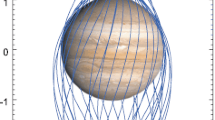Abstract
Transiting extrasolar planets (exoplanets), especially those orbiting bright stars, are desired for study of the diversity of planetary compositions, internal structures and atmospheres beyond our solar system. Dome A at Antarctica is a promising site for planetary transit surveys, where the continuous darkness and the large clear-sky fraction in the winter months greatly enhance the detection efficiency. The Chinese Small Telescope ARray and the Antarctic Survey Telescopes are the first facilities that have been operated at Dome A for use in exoplanet surveys. To increase the sky coverage, a low-temperature-resistant wide-field robotic telescope, named the bright star survey telescope (BSST), has been developed to join the ongoing planetary transit survey in Antarctica. The BSST has an aperture size of 300 mm and is equipped with a large-frame \(4K\times 4K\) CCD camera to receive starlight from a \(3.^{\circ }4 \times 3.^{\circ }4\) field of view. The BSST was operated at Lijiang observatory in April and May 2015 for a test run. Photometric precision of 3.5 mmag was achieved for stars with \(V\sim 11\) mag using 75 s exposures. The transiting events of two Jupiter-size exoplanets, HAT-P-3b and HAT-P-12b, were observed on May 10 and May 20, 2015, respectively.
摘要
具有凌星现象的太阳系外行星对研究行星的成分,结构和大气性质具有重要意义,南极冰穹A的极夜连续观测窗口和极佳的观测条件特别适合开展系外行星的测光搜寻。为了提高现有巡天(CSTAR和AST)的天区覆盖,我们研制了一台耐低温、大视场的测光望远镜,即亮星巡天望远镜(BSST),其口径300 mm,配备4K×4K CCD相机,视场3.°4×3.°4。BSST对V~11等星进行75秒曝光的实测测光精度为3.5 mmag。在丽江试观测期间,成功观测了两个已知系外行星HAT-P-3b和HAT-P-12b的凌星事件。





Similar content being viewed by others
Notes
The updated ephemerides were applied to calculate the phase offset between the two light curves.
References
Mayor M, Queloz D (1995) A Jupiter-mass companion to a solar-type star. Nature 378:355–359
Marcy GW, Butler RP (1996) A planetary companion to 70 virginis. Astrophys J 464:L147–L151
Charbonneau D, Brown TM, Latham DW et al (2000) Detection of planetary transits across a sun-like star. Astrophys J 529:L45–L48
Bakos G, Noyes RW, Kovács G et al (2004) Wide-field millimagnitude photometry with the HAT: a tool for extrasolar planet detection. Publ Astron Soc Pac 116:266–277
Pollacco DL, Skillen I, Collier CA et al (2006) The WASP project and the SuperWASP cameras. Publ Astron Soc Pac 118:1407–1418
Pepper J, Pogge RW, DePoy DL et al (2007) The kilodegree extremely little telescope (KELT): a small robotic telescope for large-area synoptic surveys. Publ Astron Soc Pac 119:923–935
Fortney JJ, Marley MS, Barnes JW (2007) Planetary radii across five orders of magnitude in mass and stellar insolation: application to transits. Astrophys J 659:1661–1672
Burrows AS (2014) Highlights in the study of exoplanet atmospheres. Nature 513:345–352
Ricker GR, Winn JN, Vanderspek R et al (2014) Transiting exoplanet survey satellite (TESS). Proc SPIE 9143:914320
Broeg C, Fortier A, Ehrenreich D et al (2013) CHEOPS: a transit photometry mission for ESA’s small mission programme. Europ Phys J Web Conf 47:03005
Wheatley PJ, Pollacco DL, Queloz D et al (2013) The next generation transit survey (NGTS). Europ Phys J Web Conf 47:13002
Brown TM (2003) Expected detection and false alarm rates for transiting jovian planets. Astrophys J 593:L125–L128
Yang H, Allen G, Ashley MCB et al (2009) The PLATO Dome A site-testing observatory: instrumentation and first results. Publ Astron Soc Pac 121:174–184
Tang X, Sun B, Guo J et al (2015) A freeze-on ice zone along the Zhongshan–Kunlun ice sheet profile, East Antarctica, by a new ground-based ice-penetrating radar. Sci Bull 60:574–576
Zou H, Zhou X, Jiang Z et al (2010) Sky brightness and transparency in the i band at Dome A, Antarctica. Astron J 140:602–611
Law NM, Carlberg R, Salbi P et al (2013) Exoplanets from the arctic: the first wide-field survey at 80°N. Astron J 145:58–68
Kenyon SL, Lawrence JS, Ashley MCB et al (2006) Atmospheric scintillation at Dome C, Antarctica: implications for photometry and astrometry. Publ Astron Soc Pac 118:924–932
Hagelin S, Masciadri E, Lascaux F et al (2008) Comparison of the atmosphere above the South Pole, Dome C and Dome A: first attempt. Mon Not R Astron Soc 387:1499–1510
Yuan X, Cui X, Liu G et al (2008) Chinese small telescope ARray (CSTAR) for antarctic Dome A. Proc SPIE 7012:70124G
Wang SH, Zhou X, Zhang H et al (2014) The correction of diurnal effects on CSTAR photometry. Res Astron Astrophys 14:345–356
Wang S, Zhang H, Zhou JL et al (2014) Planetary transit candidates in the CSTAR field: analysis of the 2008 Data. Astrophys J Suppl Ser 211:26–40
Ivezić Ž, Smith JA, Miknaitis G et al (2007) Sloan digital sky survey standard star catalog for stripe 82: the dawn of industrial 1 % optical photometry. Astron J 134:973–998
Li ZY, Lu HP, Yuan XY (2015) Optical design for Antarctic bright star survey telescope. Chin Opt Lett 13:111101
Zhang GY, Wang J, Tang PY et al (2016) An autonomous observation and control system based on EPICS and RTS2 for Antarctic telescopes. Mon Not R Astron Soc 455:1654–1664
Dravins D, Lindegren L, Mezey E et al (1998) Atmospheric intensity scintillation of stars. III. Effects for different telescope apertures. Publ Astron Soc Pac 110:610–633
Manfroid J (1995) Stellar calibration of CCD flat fielding. Astron Astrophys 113:587
Manfroid J, Royer P, Rauw G et al (2001) Correction of systematic errors in differential photometry. Astron Data Anal Softw Syst X 238:373
Bonner CS, Ashley MCB, Cui X et al (2010) Thickness of the atmospheric boundary layer above Dome A, Antarctica, during 2009. Publ Astron Soc Pac 122:1122–1131
Zhang SH, Zhou HY, Shi XH et al (2015) Discovery of extremely broad Balmer absorption lines in SDSS J152350.42+391405.2. Astrophys J 815:113–123
Mao YN, Lu XM, Wang JF (2014) Simultaneous multicolor photometry of fast-moving objects using the 1-meter telescope at Xinglong Observatory. Sci China Phys Mech Astron 57:562–568
Rong J, Buser R (2000) The Galactic population components and their structural parameter values. Chin Sci Bull 45:1362–1364
Jester S, Schneider DP, Richards GT et al (2005) The Sloan digital sky survey view of the palomar-green bright quasar survey. Astron J 130:873–895
Torres G, Bakos GÁ, Kovács G et al (2007) HAT-P-3b: a heavy-element-rich planet transiting a K dwarf star. Astrophys J 666:L121–L214
Hartman JD, Bakos GÁ, Torres G et al (2009) HAT-P-12b: a low-density sub-saturn mass planet transiting a metal-poor K dwarf. Astrophys J 706:785–796
Nascimbeni V, Piotto G, Bedin LR et al (2011) TASTE: the Asiago search for transit timing variations of exoplanets. I. Overview and improved parameters for HAT-P-3b and HAT-P-14b. Astron Astrophys 527:A85–A94
Nascimbeni V, Piotto G, Pagano I et al (2013) The blue sky of GJ3470b: the atmosphere of a low-mass planet unveiled by ground-based photometry. Astron Astrophys 559:A32
Acknowledgments
The authors appreciate the enlightening suggestions from the referees, which helped to improve the quality of this paper. This work is supported by the Astronomical Project for the Chinese Antarctic Inland Station, the SOC Program (CHINARE2012-02-03, CHINARE2013-02-03, CHINARE2014-02-03, and CHINARE2015-02-03), and the National Basic Research Program of China (2013CB834905 and 2015CB857005). Q. Tian is supported by the National Natural Science Foundation of China (11503023), the Natural Science Foundation of Shanghai (14ZR1444100), and the Polar Science Innovation Fund for Young Scientists of Polar Research Institute of China (CX20130201). P. Jiang is supported by the National Natural Science Foundation of China (11233002 and 11203022). H. Zhou is supported by the National Natural Science Foundation of China (11473025, 11421303 and 11033007). S. Zhang is supported by the National Natural Science Foundation of China (11573024). T. Ji is supported by the National Natural Science Foundation of China (11503022) and the Natural Science Foundation of Shanghai (15ZR1444200).
Author information
Authors and Affiliations
Corresponding author
Ethics declarations
Conflict of interest
The authors declare that they have no conflict of interest.
About this article
Cite this article
Tian, Q., Jiang, P., Du, F. et al. The bright star survey telescope for the planetary transit survey in Antarctica. Sci. Bull. 61, 383–390 (2016). https://doi.org/10.1007/s11434-016-1015-0
Received:
Revised:
Accepted:
Published:
Issue Date:
DOI: https://doi.org/10.1007/s11434-016-1015-0




